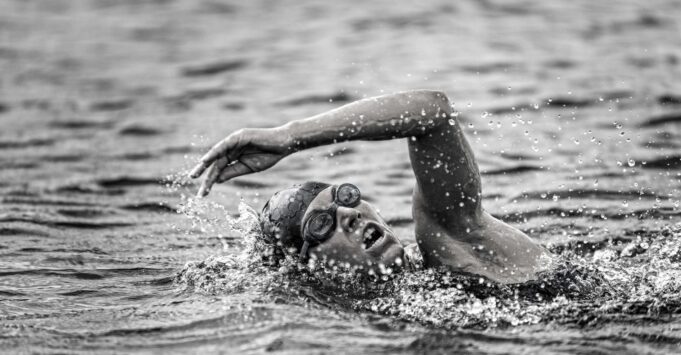If you’re considering transitioning from running to triathlon, you’re in for an exciting journey. Triathlon combines swimming, cycling, and running into one event, offering a diverse and challenging experience. Here’s a guide to help you make the transition smoothly.
How far is a triathlon?
Triathlon comes in various distances, each offering a different level of challenge:
How far is a sprint triathlon?
This is the shortest standard triathlon distance and a great starting point for beginners. It typically includes a 750-meter swim, a 20-kilometer bike ride, and a 5-kilometer run.
How far is an Olympic Triathlon?
Also known as “standard” or “international” distance, this includes a 1.5-kilometer swim, a 40-kilometer bike ride, and a 10-kilometer run.
How far is a Half Ironman?
This is a more challenging distance, featuring a 1.9-kilometer swim, a 90-kilometer bike ride, and a 21.1-kilometer run.
How far is an Ironman?
This is the ultimate triathlon challenge, with a 3.8-kilometer swim, a 180-kilometer bike ride, and a full marathon (42.2 kilometers) run.
Swimming tips for triathlon beginners
Swimming is often considered the most challenging part of a triathlon, especially for those who are new to the sport. However, with the right approach and plenty of practice, you can improve your swimming skills and gain confidence in the water. Here are nine swimming tips for first-time triathletes.
Get Comfortable in the Water
Before you start focusing on speed and endurance, it’s important to feel comfortable in the water. Spend time practicing floating, treading water, and basic strokes. This will help you feel more relaxed and confident, which is essential for efficient swimming.
Master Your Breathing
Proper breathing technique can significantly improve your performance and stamina. Practice exhaling underwater so that you’re ready to inhale when you turn your head to the side. This should be a continuous process – as soon as you finish inhaling, start exhaling again.
Learn the Right Technique
Good technique is crucial in swimming. It not only makes you faster but also helps you swim more efficiently, conserving energy for the bike and run stages of the triathlon. Consider getting a few swimming lessons or hiring a coach to ensure you’re using correct form.
Build Endurance Gradually
Just as you wouldn’t start your running training with a marathon, don’t dive into a 1.5-kilometer swim right away. Start with shorter distances and gradually increase as your confidence and stamina improve. Consistency is key – it’s better to swim a little every day than to do one long swim session per week.
Practice Open Water Swimming
Most triathlons take place in open water, so it’s important to practice in conditions that mimic your race. Open water swimming can be daunting due to factors like waves, currents, and murky water. Start with short sessions in a safe, designated area and always have a buddy with you for safety.
Sight Effectively
In open water, you’ll need to lift your head to sight landmarks and ensure you’re going in the right direction. Practice this during your pool sessions. Remember, the goal is to sight as infrequently as possible while still staying on course, as lifting your head can disrupt your body position and slow you down.
Get Used to a Wetsuit
If your race allows wetsuits and you choose to wear one, make sure you practice swimming in it before race day. Wetsuits provide buoyancy, which can change your body position in the water. They can also feel restrictive, so it’s important to get used to the sensation.
Train in Race-Specific Conditions
If possible, try to train in conditions that are as close as possible to your race – this includes the time of day, water temperature, and even salinity if you’re racing in the sea. This will help you prepare for the specific challenges you’ll face on race day.
Don’t Neglect the Swim-to-Bike Transition
The transition from swimming to cycling, known as T1, can be challenging, especially when you’re wet and possibly dizzy from the swim. Practice this transition during your training to make it as smooth and quick as possible.
Cycling tips for beginner triathletes
Cycling is a key component of any triathlon, and for many first-time triathletes, it’s a discipline that requires some specific attention and preparation. Here are some cycling tips to help you prepare for your first triathlon.
First triathlon bike advice
Invest in the Right Equipment
Your bike should be appropriate for the type of triathlon you’re entering. Road bikes are suitable for most triathlons, but if you’re participating in an off-road event, you might need a mountain bike. Make sure your bike is the right size for you, as an ill-fitting bike can lead to discomfort and injury.
Learn Basic Bike Maintenance
Knowing how to fix a flat tyre or adjust your bike’s gears can save you a lot of trouble during a race. Take the time to learn basic bike maintenance and always carry a repair kit during your rides
Practice Cycling After Swimming
In a triathlon, you’ll be cycling after a swim, which can feel quite different than cycling alone. Practice this during your training to get used to the transition.
Work on Your Endurance and Speed
Include both long, slow rides and short, fast intervals in your training. Long rides will build your endurance, while intervals will improve your speed and power.
Drafting
Drafting, or riding closely behind another cyclist to take advantage of their slipstream, can save you a lot of energy during a race. However, it requires skill and practice, and it’s not allowed in all races, so check the rules first.
Train on Similar Terrain
If possible, try to train on terrain that is similar to your race course. This will help you get used to any hills or technical sections and allow you to plan your pacing strategy.
Get Comfortable Riding in a Group
During a race, you’ll likely be riding close to other cyclists. Practice group rides during your training to get used to this. Remember to always communicate your intentions to the riders around you to avoid accidents.
Practice Nutrition and Hydration
Cycling is when most triathletes eat and drink, as it’s easier than during the swim or run. Practice eating and drinking during your long rides to see what works for you and to get used to the feeling.
Don’t Forget About Recovery
Cycling can be hard on your muscles, especially your quads and glutes. Make sure to include recovery in your training plan, including stretching, foam rolling, and rest days.
Triathlon naturally requires alot of dedication as you train in three sports instead of just one. Remember, enjoy the process and when training gets tough, focus on your why!






